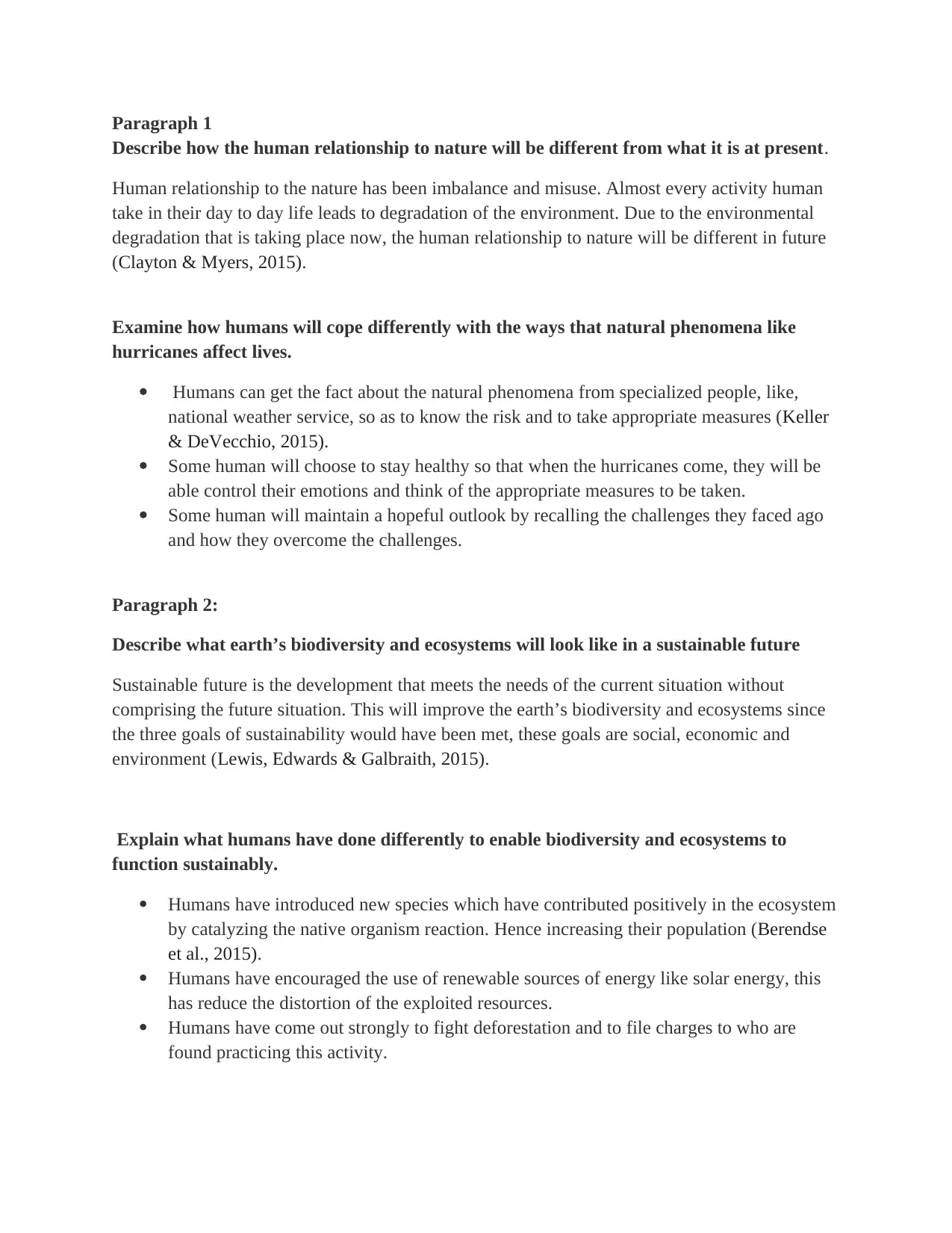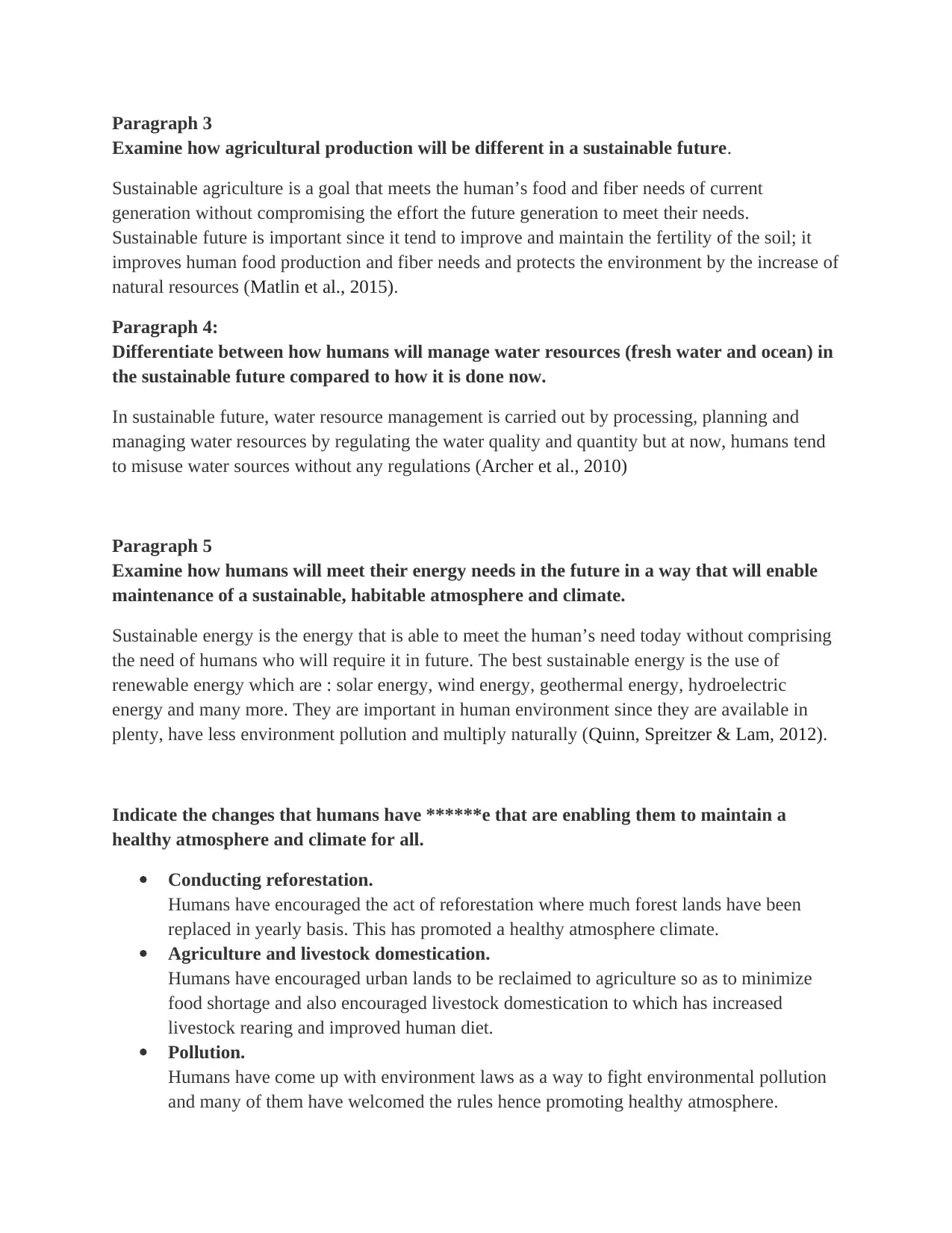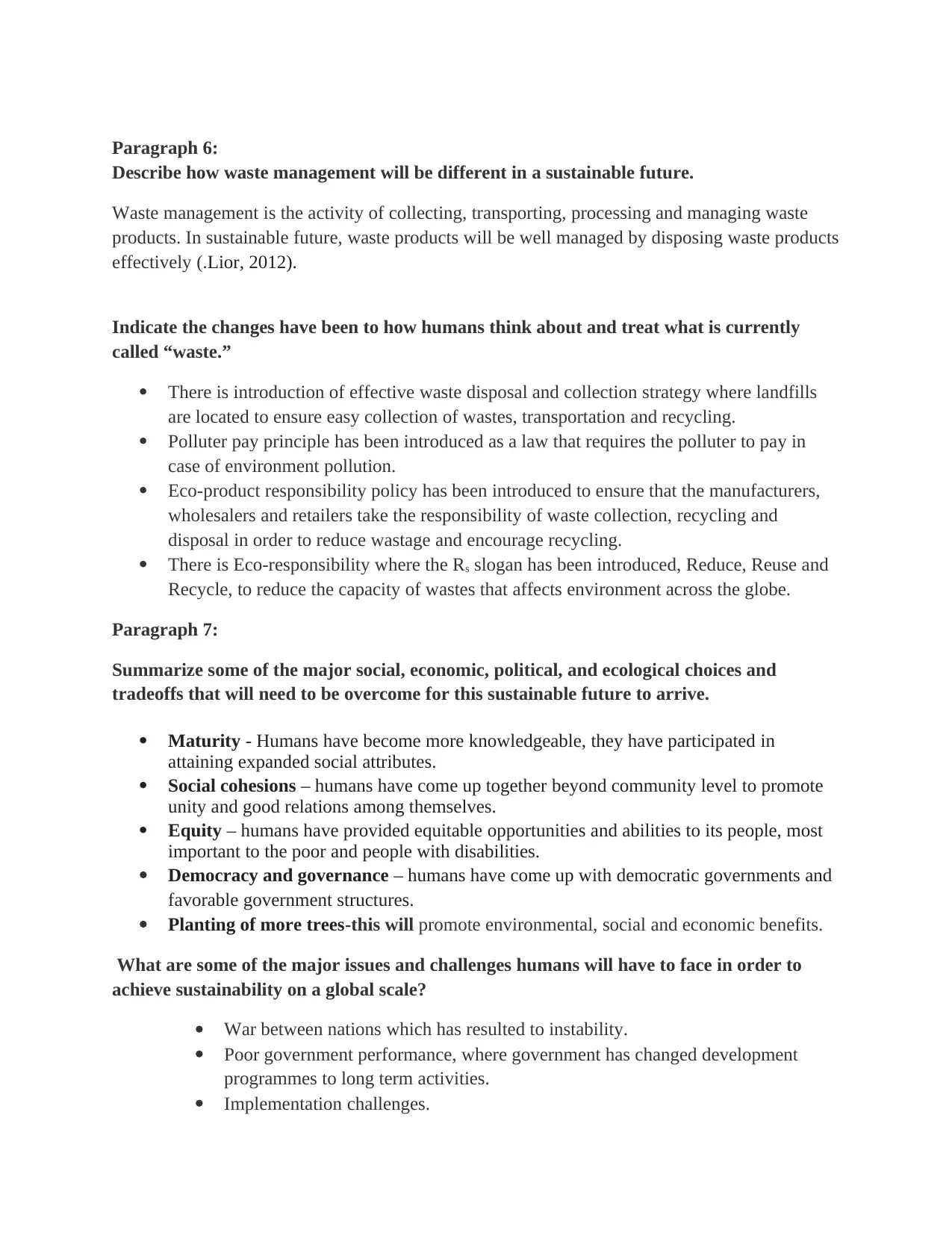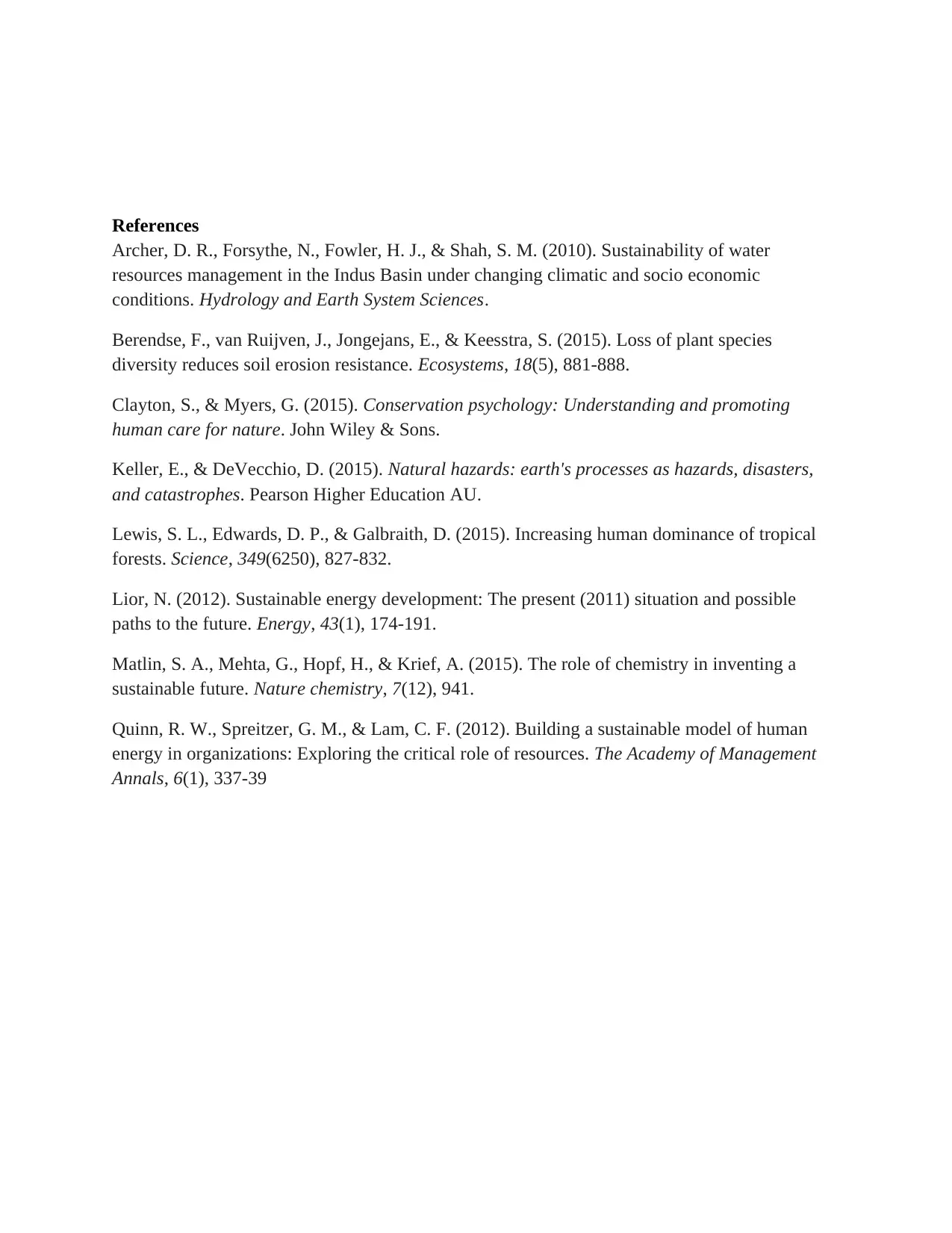Environmental Science Assignment: Sustainable Future Essay
VerifiedAdded on 2022/09/08
|5
|1405
|9
Essay
AI Summary
This essay delves into the multifaceted aspects of a sustainable future, examining the evolving relationship between humans and nature in light of current environmental degradation. It explores how humans might adapt to natural phenomena, manage biodiversity, and cultivate sustainable agricultural practices. The essay further differentiates between current and future approaches to water and energy resource management, emphasizing the shift towards renewable energy sources and the implementation of waste management strategies. It highlights the social, economic, political, and ecological choices needed to achieve global sustainability, while also addressing the major challenges humans will face in this endeavor, such as war, poor government performance, and implementation challenges. The essay concludes by emphasizing the importance of collective action, technological innovation, and policy changes to foster a sustainable and habitable environment for future generations, referencing key academic studies to support its arguments.

Paragraph 1
Describe how the human relationship to nature will be different from what it is at present.
Human relationship to the nature has been imbalance and misuse. Almost every activity human
take in their day to day life leads to degradation of the environment. Due to the environmental
degradation that is taking place now, the human relationship to nature will be different in future
(Clayton & Myers, 2015).
Examine how humans will cope differently with the ways that natural phenomena like
hurricanes affect lives.
Humans can get the fact about the natural phenomena from specialized people, like,
national weather service, so as to know the risk and to take appropriate measures (Keller
& DeVecchio, 2015).
Some human will choose to stay healthy so that when the hurricanes come, they will be
able control their emotions and think of the appropriate measures to be taken.
Some human will maintain a hopeful outlook by recalling the challenges they faced ago
and how they overcome the challenges.
Paragraph 2:
Describe what earth’s biodiversity and ecosystems will look like in a sustainable future
Sustainable future is the development that meets the needs of the current situation without
comprising the future situation. This will improve the earth’s biodiversity and ecosystems since
the three goals of sustainability would have been met, these goals are social, economic and
environment (Lewis, Edwards & Galbraith, 2015).
Explain what humans have done differently to enable biodiversity and ecosystems to
function sustainably.
Humans have introduced new species which have contributed positively in the ecosystem
by catalyzing the native organism reaction. Hence increasing their population (Berendse
et al., 2015).
Humans have encouraged the use of renewable sources of energy like solar energy, this
has reduce the distortion of the exploited resources.
Humans have come out strongly to fight deforestation and to file charges to who are
found practicing this activity.
Describe how the human relationship to nature will be different from what it is at present.
Human relationship to the nature has been imbalance and misuse. Almost every activity human
take in their day to day life leads to degradation of the environment. Due to the environmental
degradation that is taking place now, the human relationship to nature will be different in future
(Clayton & Myers, 2015).
Examine how humans will cope differently with the ways that natural phenomena like
hurricanes affect lives.
Humans can get the fact about the natural phenomena from specialized people, like,
national weather service, so as to know the risk and to take appropriate measures (Keller
& DeVecchio, 2015).
Some human will choose to stay healthy so that when the hurricanes come, they will be
able control their emotions and think of the appropriate measures to be taken.
Some human will maintain a hopeful outlook by recalling the challenges they faced ago
and how they overcome the challenges.
Paragraph 2:
Describe what earth’s biodiversity and ecosystems will look like in a sustainable future
Sustainable future is the development that meets the needs of the current situation without
comprising the future situation. This will improve the earth’s biodiversity and ecosystems since
the three goals of sustainability would have been met, these goals are social, economic and
environment (Lewis, Edwards & Galbraith, 2015).
Explain what humans have done differently to enable biodiversity and ecosystems to
function sustainably.
Humans have introduced new species which have contributed positively in the ecosystem
by catalyzing the native organism reaction. Hence increasing their population (Berendse
et al., 2015).
Humans have encouraged the use of renewable sources of energy like solar energy, this
has reduce the distortion of the exploited resources.
Humans have come out strongly to fight deforestation and to file charges to who are
found practicing this activity.
Paraphrase This Document
Need a fresh take? Get an instant paraphrase of this document with our AI Paraphraser

Paragraph 3
Examine how agricultural production will be different in a sustainable future.
Sustainable agriculture is a goal that meets the human’s food and fiber needs of current
generation without compromising the effort the future generation to meet their needs.
Sustainable future is important since it tend to improve and maintain the fertility of the soil; it
improves human food production and fiber needs and protects the environment by the increase of
natural resources (Matlin et al., 2015).
Paragraph 4:
Differentiate between how humans will manage water resources (fresh water and ocean) in
the sustainable future compared to how it is done now.
In sustainable future, water resource management is carried out by processing, planning and
managing water resources by regulating the water quality and quantity but at now, humans tend
to misuse water sources without any regulations (Archer et al., 2010)
Paragraph 5
Examine how humans will meet their energy needs in the future in a way that will enable
maintenance of a sustainable, habitable atmosphere and climate.
Sustainable energy is the energy that is able to meet the human’s need today without comprising
the need of humans who will require it in future. The best sustainable energy is the use of
renewable energy which are : solar energy, wind energy, geothermal energy, hydroelectric
energy and many more. They are important in human environment since they are available in
plenty, have less environment pollution and multiply naturally (Quinn, Spreitzer & Lam, 2012).
Indicate the changes that humans have ******e that are enabling them to maintain a
healthy atmosphere and climate for all.
Conducting reforestation.
Humans have encouraged the act of reforestation where much forest lands have been
replaced in yearly basis. This has promoted a healthy atmosphere climate.
Agriculture and livestock domestication.
Humans have encouraged urban lands to be reclaimed to agriculture so as to minimize
food shortage and also encouraged livestock domestication to which has increased
livestock rearing and improved human diet.
Pollution.
Humans have come up with environment laws as a way to fight environmental pollution
and many of them have welcomed the rules hence promoting healthy atmosphere.
Examine how agricultural production will be different in a sustainable future.
Sustainable agriculture is a goal that meets the human’s food and fiber needs of current
generation without compromising the effort the future generation to meet their needs.
Sustainable future is important since it tend to improve and maintain the fertility of the soil; it
improves human food production and fiber needs and protects the environment by the increase of
natural resources (Matlin et al., 2015).
Paragraph 4:
Differentiate between how humans will manage water resources (fresh water and ocean) in
the sustainable future compared to how it is done now.
In sustainable future, water resource management is carried out by processing, planning and
managing water resources by regulating the water quality and quantity but at now, humans tend
to misuse water sources without any regulations (Archer et al., 2010)
Paragraph 5
Examine how humans will meet their energy needs in the future in a way that will enable
maintenance of a sustainable, habitable atmosphere and climate.
Sustainable energy is the energy that is able to meet the human’s need today without comprising
the need of humans who will require it in future. The best sustainable energy is the use of
renewable energy which are : solar energy, wind energy, geothermal energy, hydroelectric
energy and many more. They are important in human environment since they are available in
plenty, have less environment pollution and multiply naturally (Quinn, Spreitzer & Lam, 2012).
Indicate the changes that humans have ******e that are enabling them to maintain a
healthy atmosphere and climate for all.
Conducting reforestation.
Humans have encouraged the act of reforestation where much forest lands have been
replaced in yearly basis. This has promoted a healthy atmosphere climate.
Agriculture and livestock domestication.
Humans have encouraged urban lands to be reclaimed to agriculture so as to minimize
food shortage and also encouraged livestock domestication to which has increased
livestock rearing and improved human diet.
Pollution.
Humans have come up with environment laws as a way to fight environmental pollution
and many of them have welcomed the rules hence promoting healthy atmosphere.

Paragraph 6:
Describe how waste management will be different in a sustainable future.
Waste management is the activity of collecting, transporting, processing and managing waste
products. In sustainable future, waste products will be well managed by disposing waste products
effectively (.Lior, 2012).
Indicate the changes have been to how humans think about and treat what is currently
called “waste.”
There is introduction of effective waste disposal and collection strategy where landfills
are located to ensure easy collection of wastes, transportation and recycling.
Polluter pay principle has been introduced as a law that requires the polluter to pay in
case of environment pollution.
Eco-product responsibility policy has been introduced to ensure that the manufacturers,
wholesalers and retailers take the responsibility of waste collection, recycling and
disposal in order to reduce wastage and encourage recycling.
There is Eco-responsibility where the Rs slogan has been introduced, Reduce, Reuse and
Recycle, to reduce the capacity of wastes that affects environment across the globe.
Paragraph 7:
Summarize some of the major social, economic, political, and ecological choices and
tradeoffs that will need to be overcome for this sustainable future to arrive.
Maturity - Humans have become more knowledgeable, they have participated in
attaining expanded social attributes.
Social cohesions – humans have come up together beyond community level to promote
unity and good relations among themselves.
Equity – humans have provided equitable opportunities and abilities to its people, most
important to the poor and people with disabilities.
Democracy and governance – humans have come up with democratic governments and
favorable government structures.
Planting of more trees-this will promote environmental, social and economic benefits.
What are some of the major issues and challenges humans will have to face in order to
achieve sustainability on a global scale?
War between nations which has resulted to instability.
Poor government performance, where government has changed development
programmes to long term activities.
Implementation challenges.
Describe how waste management will be different in a sustainable future.
Waste management is the activity of collecting, transporting, processing and managing waste
products. In sustainable future, waste products will be well managed by disposing waste products
effectively (.Lior, 2012).
Indicate the changes have been to how humans think about and treat what is currently
called “waste.”
There is introduction of effective waste disposal and collection strategy where landfills
are located to ensure easy collection of wastes, transportation and recycling.
Polluter pay principle has been introduced as a law that requires the polluter to pay in
case of environment pollution.
Eco-product responsibility policy has been introduced to ensure that the manufacturers,
wholesalers and retailers take the responsibility of waste collection, recycling and
disposal in order to reduce wastage and encourage recycling.
There is Eco-responsibility where the Rs slogan has been introduced, Reduce, Reuse and
Recycle, to reduce the capacity of wastes that affects environment across the globe.
Paragraph 7:
Summarize some of the major social, economic, political, and ecological choices and
tradeoffs that will need to be overcome for this sustainable future to arrive.
Maturity - Humans have become more knowledgeable, they have participated in
attaining expanded social attributes.
Social cohesions – humans have come up together beyond community level to promote
unity and good relations among themselves.
Equity – humans have provided equitable opportunities and abilities to its people, most
important to the poor and people with disabilities.
Democracy and governance – humans have come up with democratic governments and
favorable government structures.
Planting of more trees-this will promote environmental, social and economic benefits.
What are some of the major issues and challenges humans will have to face in order to
achieve sustainability on a global scale?
War between nations which has resulted to instability.
Poor government performance, where government has changed development
programmes to long term activities.
Implementation challenges.
⊘ This is a preview!⊘
Do you want full access?
Subscribe today to unlock all pages.

Trusted by 1+ million students worldwide

References
Archer, D. R., Forsythe, N., Fowler, H. J., & Shah, S. M. (2010). Sustainability of water
resources management in the Indus Basin under changing climatic and socio economic
conditions. Hydrology and Earth System Sciences.
Berendse, F., van Ruijven, J., Jongejans, E., & Keesstra, S. (2015). Loss of plant species
diversity reduces soil erosion resistance. Ecosystems, 18(5), 881-888.
Clayton, S., & Myers, G. (2015). Conservation psychology: Understanding and promoting
human care for nature. John Wiley & Sons.
Keller, E., & DeVecchio, D. (2015). Natural hazards: earth's processes as hazards, disasters,
and catastrophes. Pearson Higher Education AU.
Lewis, S. L., Edwards, D. P., & Galbraith, D. (2015). Increasing human dominance of tropical
forests. Science, 349(6250), 827-832.
Lior, N. (2012). Sustainable energy development: The present (2011) situation and possible
paths to the future. Energy, 43(1), 174-191.
Matlin, S. A., Mehta, G., Hopf, H., & Krief, A. (2015). The role of chemistry in inventing a
sustainable future. Nature chemistry, 7(12), 941.
Quinn, R. W., Spreitzer, G. M., & Lam, C. F. (2012). Building a sustainable model of human
energy in organizations: Exploring the critical role of resources. The Academy of Management
Annals, 6(1), 337-39
Archer, D. R., Forsythe, N., Fowler, H. J., & Shah, S. M. (2010). Sustainability of water
resources management in the Indus Basin under changing climatic and socio economic
conditions. Hydrology and Earth System Sciences.
Berendse, F., van Ruijven, J., Jongejans, E., & Keesstra, S. (2015). Loss of plant species
diversity reduces soil erosion resistance. Ecosystems, 18(5), 881-888.
Clayton, S., & Myers, G. (2015). Conservation psychology: Understanding and promoting
human care for nature. John Wiley & Sons.
Keller, E., & DeVecchio, D. (2015). Natural hazards: earth's processes as hazards, disasters,
and catastrophes. Pearson Higher Education AU.
Lewis, S. L., Edwards, D. P., & Galbraith, D. (2015). Increasing human dominance of tropical
forests. Science, 349(6250), 827-832.
Lior, N. (2012). Sustainable energy development: The present (2011) situation and possible
paths to the future. Energy, 43(1), 174-191.
Matlin, S. A., Mehta, G., Hopf, H., & Krief, A. (2015). The role of chemistry in inventing a
sustainable future. Nature chemistry, 7(12), 941.
Quinn, R. W., Spreitzer, G. M., & Lam, C. F. (2012). Building a sustainable model of human
energy in organizations: Exploring the critical role of resources. The Academy of Management
Annals, 6(1), 337-39
Paraphrase This Document
Need a fresh take? Get an instant paraphrase of this document with our AI Paraphraser

1 out of 5
Related Documents
Your All-in-One AI-Powered Toolkit for Academic Success.
+13062052269
info@desklib.com
Available 24*7 on WhatsApp / Email
![[object Object]](/_next/static/media/star-bottom.7253800d.svg)
Unlock your academic potential
Copyright © 2020–2025 A2Z Services. All Rights Reserved. Developed and managed by ZUCOL.



